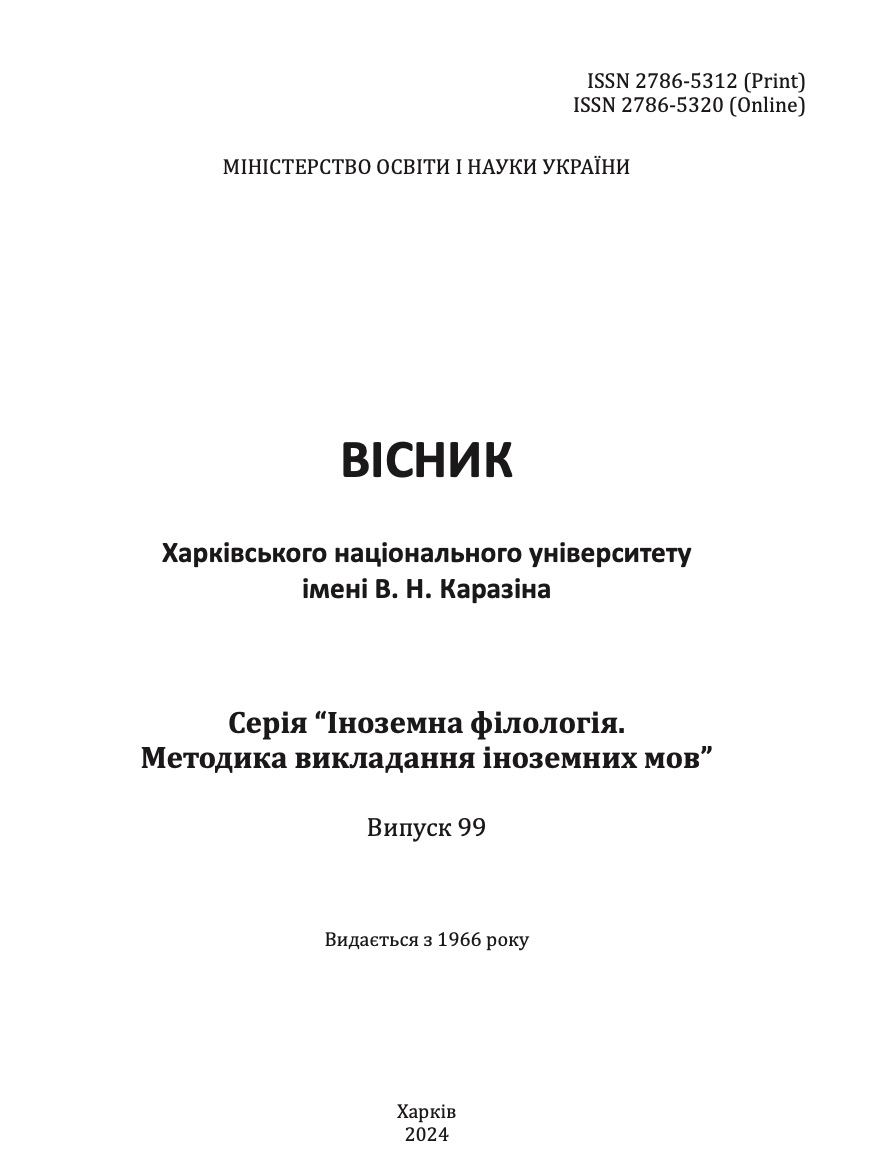Integrating transmedia into the process of teaching foreign languages: opportunities and challenges
Abstract
The article is focused on the study of ways of using transmedia technologies in foreign language classes. The issues of engaging students in the learning process in a distance format, maintaining their interest and motivation to learn require answers and the search for new opportunities. This is what stipulates the relevance of this study. The purpose of the study is to determine the specifics of using transmedia technologies for teaching a professional foreign language in a higher education institution. The object of the study is the phenomenon of transmediation and relevant technologies in education, and the subject is the methods and techniques of using transmedia technologies in English language classes. A thorough analysis of the use of modern media technologies by educators from different countries shows that there are few developed methods of teaching foreign languages based on transmedia technologies. The article studies the advantages of using transmedia in the educational process and their impact on learning outcomes. Examples of transmedia tasks and projects that can be used in foreign language classes prove that the effectiveness of transmedia is due to the various opportunities for improving students’ reading, speaking, listening and writing skills, as well as developing their communicative competences through transmedia. The authors, however, emphasise certain challenges, mainly related to the lack of transmedia literacy of teachers. Improving digital skills beyond basic knowledge is a prerequisite for the effective implementation of transmedia technologies.
Downloads
References
Vezhnevets’, I. L. (2019). “Muzychnyj portret” iak khudozhnia forma frantsuz’koi vokal’noi kul’tury KhKh stolittia. (Dys.kand. mystetstvoznavstva). [“Musical portrait” as an artistic form of twentieth-century French vocal culture (Art PhD thesis)]. Natsional’na akademiia kerivnykh kadriv kul’tury i mystetstv, Kyiv. (in Ukrainian)
Zhenchenko, M. I. (2013). Poniattia ‘mul’tymedia’, ‘kros-media’, ‘transmedia’ u naukovomu dyskursi tsyfrovoi doby [The concepts of ‘multimedia’, ‘cross-media’, ‘transmedia’ in the scientific discourse of the digital age]. Naukovi zapysky Instytutu zhurnalistyky, 52, 72-75. Retrieved from: http://nbuv.gov.ua/UJRN/Nzizh_2013_52_12 (in Ukrainian).
Stiekol’schykova, V. A. (2020). Videostoritelinh iak efektyvna model’ ta forma u strukturi iakisnoho investyhejtornoho material [Video storytelling as an effective model and form in the structure of high-quality investment-generating material]. Vcheni zapysky TNU imeni V. I. Vernads’koho. Seriia: Filolohiia. Sotsial’ni komunikatsii, 31(70), № 3, 174–177. (in Ukrainian)
Tymchuk, L. (2017). Teoretyko-metodychni zasady proektuvannia tsyfrovykh naratyviv u navchanni majbutnikh mahistriv osvity (Avtoreferat doktorskoi dysertatsii) [Theoretical and Methodological Foundations of Designing Digital Narratives in the Education of Future Masters of Education (Doctor of Sciences synopsis)]. Instytut informatsiinykh tekhnolohii i zasobiv navchannia NАPN Ukrainy, Kyiv. (in Ukrainian)
Caceda, A. & León, V. (2022). YouTube and Transmedia Storytelling on Educational Marketing of a Business School in Perú. Proceedings of the 2022 International Conference on International Studies in Social Sciences and Humanities, 50-64. http://doi.org/10.2991/978-2-494069-25-1.
Derbaix, M., Bourgeon, D., Jarrier, E. & Petr, Ch. (2017). Transmedia Experience and Narrative Transportation. Journal of Marketing Trends, 4(2), 39-48.
Eder, J. (2015). Transmediality and the politics of adaptation: Concepts, forms, and strategies. In Hassler-Forest, D. & Nicklas, P. (Eds.) The politics of adaptation (pp. 66–81). Basingstoke: Palgrave Macmillan.
Fleming, L. (2013). Expanding Learning Opportunities with Transmedia Practices: Inanimate Alice as an Exemplar. Journal of Media Literacy Education, 5(2), 370–377 https://doi.org/10.23860/jmle-5-2-3.
Freixa, P., Sora-Domenjó, C. & Soler-Adillon. J. (2022). Webdocs: social interaction and transmedia. In Freixa, P., Codina, L., Pérez-Montoro, M. & Guallar, J. (Eds.). Visualisations and narratives in digital media: methods and current trends. Barcelona: Universitat Pompeu Fabra, Ediciones Profesionales de la Información (pp. 82-100). http://doi.org/10.3145/indocs.2022.6.
González-Martínez, J., Esteban-Guitart, M., Rostan-Sanchez, C., Serrat-Sellabona, E. & Estebanell-Minguell, M. (2019). What’s up with transmedia and education? A literature review). Digital Education Review, 36, 207-222. Retrieved from: https://revistes.ub.edu/index.php/der/article/view/26784.
Herrero, C. (2022). Applications of transmedia practices and open educational resources in higher education. Materials of the conference ‘Visual Literacy and Digital Communication: the role of media in new educational practices’ 18–19 December, Madrid: Facultad de Filologia, 43–60.
Jenkins, H. (2003). Transmedia storytelling moving characters from books to films to video games can make them stronger and more compelling. MIT Technology Review. Retrieved from: https://www.technologyreview.com/2003/01/15/234540/transmedia-storytelling/.
Jenkins, H. (2006). Convergence Culture: Where Old and New Media Collide. New York: NYU Press. Retrieved from: http://www.jstor.org/stable/j.ctt9qffwr.
Jenkins, H. (2009). Confronting the Challenges of Participatory Culture: Media Education for the 21st Century. Cambridge: MIT Press.
Ketzer-Nöltge, A. (2024). Potentials of immersive digital learning environments – teaching and learning languages in 360° and VR. Каразінські читання: Людина. Мова. Комунікація: матеріали наук. конф. з міжнар. уч. 02 лютого. Харків: ХНУ імені В.Н Каразіна, 45.
Kinder, M. (1991). Playing with Power in Movies, Television, and Video Games: From Muppet Babies to Teenage Mutant Ninja Turtles. Berkeley and Los Angeles: University of California Press.
Lynch, D. (2016). Between the network and the narrative: transmedia storytelling as a philosophical lens for creative writers. New Writing, 13:2, 161–172. https://doi.org/10.1080/14790726.2016.1170858.
Özbölük, T. (2018). The Marketer as Storyteller: Transmedia Marketing in a Participatory Culture. In Yilmaz, R., Nur Erdem, M. & Resuloğlu, F. (Eds.). Handbook of Research on Transmedia Storytelling and Narrative Strategies (pp. 310–329). Ankara: IGI Global.
Poda, Т. (2021). Storytelling as a modern communication phenomenon. Proceedings of the National Aviation University. Philosophy. Cultural Studies: collection of scientific papers, 2 (34), 102–107.
Sánchez-Caballé, A. & González-Martínez, J. (2023). Transmedia learning: fact or fiction? A systematic review. Culture and Education, 35(1), 1–32. https://doi.org/10.1080/11356405.2022.2121131.
Scolari, C. A. (Ed.). (2018). Teens, media and collaborative cultures: exploiting teens’ transmedia skills in the classroom. Barcelona: H2020 TRANSLITERACY Project. Retrieved from: https://transmedialiteracy.org/.
Scolari, C. A., Masanet, M.-J., Guerrero Pico, M. & Estables, M.-J. (2019). Transmedia Literacy in the New Media Ecology. An International Map of Teens’ Transmedia Skills. Pittsburgh, PA: ETC Press. http://doi.org/801.10.3145/epi.2018.jul.09.
Vorobyova, O. (2022). Multimodality and transmediality in Kamal Abdulla’s short fiction: a cognitive-emotive interface. Cognition, Communication, Discourse, 24, 91-102. http://doi.org/10.26565/2218-2926-2022-24-07.




